
Bytom is a city in Upper Silesia, in southern Poland. Located in the Silesian Voivodeship of Poland, the city is 7 km northwest of Katowice, the regional capital.

Parczew is a town in eastern Poland, with a population of 10,281 (2006). It is the capital of Parczew County in the Lublin Voivodeship.
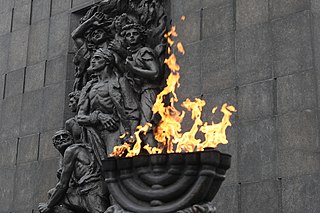
The history of the Jews in Poland dates back at least 1,000 years. For centuries, Poland was home to the largest and most significant Ashkenazi Jewish community in the world. Poland was a principal center of Jewish culture, because of the long period of statutory religious tolerance and social autonomy which ended after the Partitions of Poland in the 18th century. During World War II there was a nearly complete genocidal destruction of the Polish Jewish community by Nazi Germany and its collaborators of various nationalities, during the German occupation of Poland between 1939 and 1945, called the Holocaust. Since the fall of communism in Poland, there has been a renewed interest in Jewish culture, featuring an annual Jewish Culture Festival, new study programs at Polish secondary schools and universities, and the opening of Warsaw's Museum of the History of Polish Jews.
Following the establishment of the Second Polish Republic after World War I and during the interwar period, the number of Jews in the country grew rapidly. According to the Polish national census of 1921, there were 2,845,364 Jews living in the Second Polish Republic; by late 1938 that number had grown by over 16 percent, to approximately 3,310,000, mainly through migration from Ukraine and the Soviet Russia. The average rate of permanent settlement was about 30,000 per annum. At the same time, every year around 100,000 Jews were passing through Poland in unofficial emigration overseas. Between the end of the Polish–Soviet War of 1919 and late 1938, the Jewish population of the Republic grew by nearly half a million, or over 464,000 persons. Jews preferred to live in the relatively-tolerant Poland rather than in the Soviet Union and continued to integrate, marry into Polish Gentile families, to bring them into their community through marriage, feel Polish and form an important part of Polish society. Between 1933 and 1938, around 25,000 German Jews fled Nazi Germany to sanctuary in Poland.
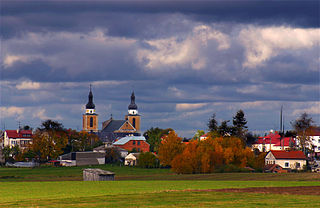
Stawiski is a town in northeastern Poland, situated within Kolno County, in Podlaskie Voivodeship, approximately 16 kilometres east of Kolno and 74 kilometres west of the regional capital Białystok. Stawiski is the administrative seat of Gmina Stawiski. From 1946 to 1975 it belonged administratively to Białystok Voivodeship, and from 1975 to 1998 to Łomża Voivodeship. The town is situated on the Dzierzbia River.

The history of the Jews during World War II is almost synonymous with the persecution and murder of Jews which was committed on an unprecedented scale in Europe and European North Africa. The massive scale of the Holocaust which happened during World War II greatly affected the Jewish people and world public opinion, which only understood the dimensions of the Final Solution after the war. The genocide, known as HaShoah in Hebrew, aimed at the elimination of the Jewish people on the European continent. It was a broadly organized operation led by Nazi Germany, in which approximately six million Jews were murdered methodically and with horrifying cruelty. Although the Holocaust was organized by the highest levels of the Nazi German government, the vast majority of Jews murdered were not German, but were instead residents of countries invaded by the Nazis after 1938. Of the approximately 6 million Jews murdered by the Nazis, approximately 160,000 to 180,000 were German Jews. During the Holocaust in occupied Poland, more than one million Jews were murdered in gas chambers of the Auschwitz concentration camp alone. The murder of the Jews of Europe affected Jewish communities in Albania, Austria, Belarus, Belgium, Bosnia & Herzegovina, Channel Islands, Croatia, Czech Republic, Estonia, France, Germany, Greece, Hungary, Italy, Latvia, Libya, Lithuania, Luxembourg, Moldova, the Netherlands, North Macedonia, Norway, Poland, Romania, Russia, Serbia, Slovakia, and Ukraine.

The Holocaust in Poland was part of the European-wide Holocaust organized by Nazi Germany and took place in German-occupied Poland. During the genocide, three million Polish Jews were murdered, half of all Jews murdered during the Holocaust.
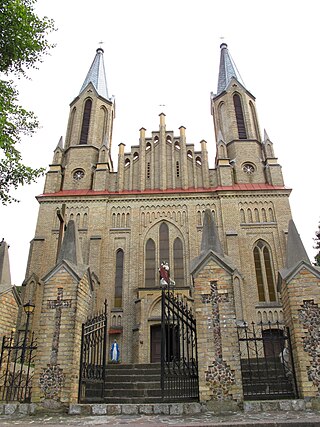
Krynkipronounced [ˈkrɨŋkʲi] is a town in northeastern Poland, located in Podlaskie Voivodeship along the border with Belarus. It lies approximately 24 kilometres (15 mi) south-east of Sokółka and about 45 km (28 mi) east of the regional capital Białystok.

The history of the Jews in North Macedonia stretches back two thousand years, beginning during Roman antiquity, when Jews first arrived in the region. Today, following the Holocaust and emigration, especially to Israel, around 200 Jews remain in North Macedonia, mostly in the capital, Skopje and a few in Štip and Bitola.

Bytom Synagogue or Beuthen Synagogue was a synagogue in Beuthen, in the Prussian Province of Silesia, a border–town between Germany and the Second Polish Republic prior to German invasion of Poland in World War II. After the plebiscite of 1922, the border passed just east of Beuthen, so that neighboring Katowice was in Poland.

Działoszyce(listen) is a town in Świętokrzyskie Voivodeship, Poland, with 2882 inhabitants as of December 2023.

Holocaust trains were railway transports run by the Deutsche Reichsbahn national railway system under the control of Nazi Germany and its allies, for the purpose of forcible deportation of the Jews, as well as other victims of the Holocaust, to the Nazi concentration, forced labour, and extermination camps.

In the early modern era, European Jews were confined to ghettos and placed under strict regulations as well as restrictions in many European cities. The character of ghettos fluctuated over the centuries. In some cases, they comprised a Jewish quarter, the area of a city traditionally inhabited by Jews. In many instances, ghettos were places of terrible poverty and during periods of population growth, ghettos had narrow streets and small, crowded houses. Residents had their own justice system. Around the ghetto stood walls that, during pogroms, were closed from inside to protect the community, but from the outside during Christmas, Pesach, and Easter Week to prevent the Jews from leaving at those times.

The Będzin Ghetto was a World War II ghetto set up by Nazi Germany for the Polish Jews in the town of Będzin in occupied south-western Poland. The formation of the 'Jewish Quarter' was pronounced by the German authorities in July 1940. Over 20,000 local Jews from Będzin, along with additional 10,000 Jews expelled from neighbouring communities, were forced to subsist there until the end of the ghetto history during the Holocaust. Most of the able-bodied poor were forced to work in German military factories before being transported aboard Holocaust trains to the nearby concentration camp at Auschwitz where they were exterminated. The last major deportation of the ghetto inmates by the German SS – men, women and children – between 1 and 3 August 1943 was marked by the ghetto uprising by members of the Jewish Combat Organization.

The Grodno Ghetto was a Nazi ghetto established in November 1941 by Nazi Germany in the city of Grodno for the purpose of persecution and exploitation of Jews in Western Belarus.

Radom Ghetto was a Nazi ghetto set up in March 1941 in the city of Radom during the Nazi occupation of Poland, for the purpose of persecution and exploitation of Polish Jews. It was closed off from the outside officially in April 1941. A year and a half later, the liquidation of the ghetto began in August 1942, and ended in July 1944, with approximately 30,000–32,000 victims deported aboard Holocaust trains to their deaths at the Treblinka extermination camp.
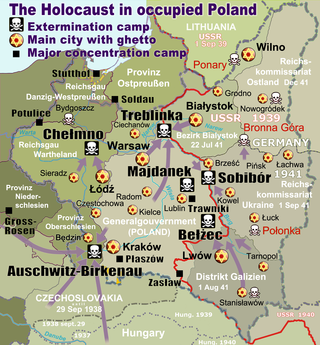
The Pińsk Ghetto was a Nazi ghetto created by Nazi Germany for the confinement of Jews living in the city of Pińsk, Western Belarus. Pińsk, located in eastern Poland, was occupied by the Red Army in 1939 and incorporated into the Byelorussian SSR. The city was captured by the Wehrmacht in Operation Barbarossa in July 1941; it was incorporated into the German Reichskommissariat Ukraine in autumn of 1941.

The Lutsk Ghetto was a Nazi ghetto established in 1941 by the SS in Lutsk, Western Ukraine, during World War II. In the interwar period, the city was known as Łuck and was part of the Wołyń Voivodeship (1921–1939) in the Second Polish Republic.
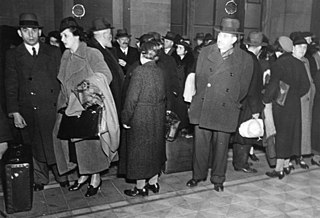
In October 1938, about 17,000 Polish Jews living in Nazi Germany were arrested and expelled. These deportations, termed by the Nazis Polenaktion, were ordered by SS officer and head of the Gestapo Reinhard Heydrich. The deported Jews were rejected by Poland and therefore had to live in makeshift encampments along the Germany–Poland border.

















